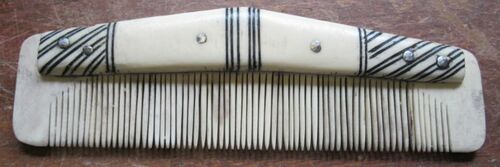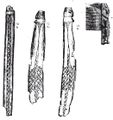Difference between revisions of "Combs"
m |
m |
||
| (7 intermediate revisions by the same user not shown) | |||
| Line 39: | Line 39: | ||
They are most common in the Netherlands, but also appear in small numbers in the southern British Isles. | They are most common in the Netherlands, but also appear in small numbers in the southern British Isles. | ||
| − | |||
| − | ===England, York: Coppergate=== | + | |
| + | ===[[:Category:Our Replicas|Replica by Gavin Archer]] - England, York: Coppergate=== | ||
| + | [[File:Type 2c York, 7550 - GAV.JPG|thumb|500px|left|Replica created by Gavin Archer 2017]] | ||
| + | |||
{{Cat| | {{Cat| | ||
:Find Type- ? | :Find Type- ? | ||
| Line 49: | Line 51: | ||
:Comments- | :Comments- | ||
:Bibliography- | :Bibliography- | ||
| − | :*{{ListRef| | + | :*{{ListRef|Macgregor, Mainman & Rogers 1999|cat.7550}} |
|Seen= yes | |Seen= yes | ||
|Museum= Jorvik Viking Museum | |Museum= Jorvik Viking Museum | ||
|Accession= | |Accession= | ||
| − | |i1= | + | |i1=Type 2c York. 7550.JPG |
| − | |i2= | + | |i2= |
}} | }} | ||
| − | |||
| − | |||
| + | ==Type 3 - Handled== | ||
| + | Date: AD700-1100<br> | ||
| + | Mainly found in: England, Netherlands, Belgium<br> | ||
| + | <br> | ||
| + | Southern Style use a slotted antler tine.<br> | ||
| + | Northern Style consists of 2 connecting plates.<br> | ||
| − | |||
==Type 4 - Horn== | ==Type 4 - Horn== | ||
Latest revision as of 22:32, 9 September 2023
More Crafts pages
Intro here
Typology
We are using Steven Ashby's Typology.
Ashby Type 1a - Early Anglo-Saxon
Date: AD300-600
Mainly found in: England, Netherlands, Belgium, Denmark
Ashby Type 1b - Barred
Date: AD500-800
Mainly found in: England, Netherlands, Belgium, France
Ashby Type 1c - High-backed
Date: AD450-800
Mainly found in: Scotland, Ireland
Type 2a - Flat-sided
Date: AD600-900
Mainly found in: England, Netherlands, Belgium, France
The flat connecting plates are cut from the ribs of sheep or other domestic mammals
Type 2b - Bowed
Date: AD600-900
Mainly found in: England, Netherlands, Belgium, France
Frequently referred to as 'hogback' or 'winged' combs.
Type 2c - Coped
Date: AD600-900
Mainly found in: England, Netherlands, Belgium
They are most common in the Netherlands, but also appear in small numbers in the southern British Isles.
Replica by Gavin Archer - England, York: Coppergate
|
Type 3 - Handled
Date: AD700-1100
Mainly found in: England, Netherlands, Belgium
Southern Style use a slotted antler tine.
Northern Style consists of 2 connecting plates.
Type 4 - Horn
Type 5 - Norse
Type 6 - Short
Type 7 - Long
Type 8i - Short
Type 8ii - Long
Type 8iii -
Type 9 - Copper









